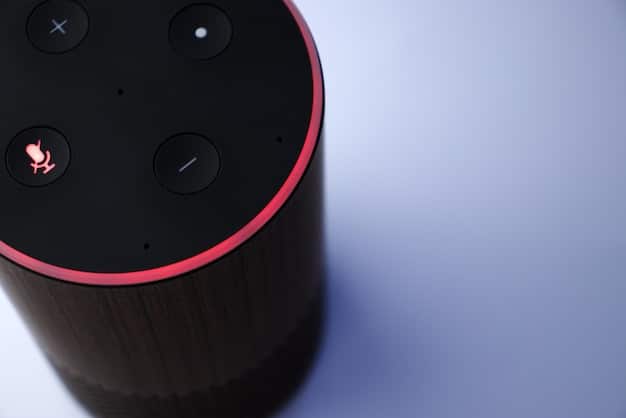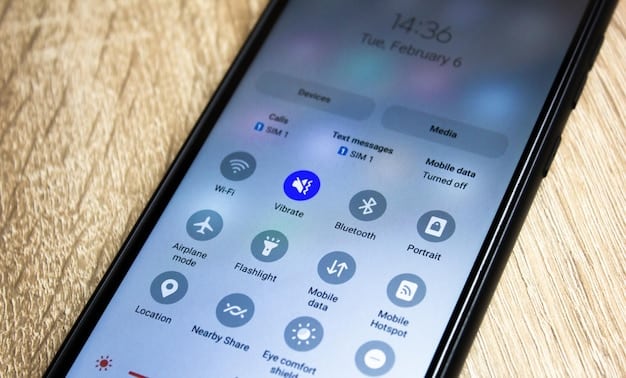Are Your Smart Home Devices Spying on You? 6 Security Tips

Smart home devices offer convenience, but they also raise privacy concerns; this article explores how your devices could be spying on you and provides six actionable ways to secure your connected home and protect your personal information.
Do you ever wonder if your smart home devices are listening in? The convenience of a connected home comes with potential privacy risks. Let’s explore how are your smart home devices spying on you? 6 ways to secure your connected home.
Understanding the Smart Home Privacy Landscape
The smart home revolution has brought unprecedented convenience to our lives. However, this convenience comes at a cost: our privacy. Understanding the landscape of smart home privacy is the first step toward securing your connected home.
The Data Collection Dilemma
Smart home devices are designed to collect data. This data, which ranges from your daily routines to your conversations, is valuable to manufacturers and advertisers. It is crucial to understand what data is being collected and how it is being used.
Who’s Listening? Microphones and Cameras
Many smart home devices, such as smart speakers and security cameras, have microphones and cameras. These sensors can be exploited to listen in on your conversations or record your activities. It is essential to be aware of which devices have these capabilities and take steps to protect your privacy.
- Regularly check the camera and microphone permissions for each of your smart devices.
- Consider covering cameras when not in use.
- Disable microphones when possible.
Manufacturers are not always transparent about how they use the data they collect, and privacy policies can be difficult to understand. Therefore, it is crucial to be proactive in protecting your privacy.

Securing Your Wi-Fi Network
Your Wi-Fi network is the gateway to your smart home. Securing it is essential to prevent unauthorized access to your devices and personal information. A strong and well-protected Wi-Fi network is the foundation of a secure smart home.
Use a Strong Password
A strong password is the first line of defense against unauthorized access to your Wi-Fi network. Avoid using common passwords like “password” or “123456.” Instead, choose a complex password that includes a combination of upper and lowercase letters, numbers, and symbols.
Enable WPA3 Encryption
WPA3 is the latest Wi-Fi security protocol. It offers stronger encryption and better protection against hacking than older protocols like WPA2. Make sure your router supports WPA3 and enable it for your network.
- Check your router’s settings to see if WPA3 is available.
- If your router doesn’t support WPA3, consider upgrading to a newer model.
- Regularly update your router’s firmware to patch security vulnerabilities.
Securing your Wi-Fi network is a continuous process. Regularly review your security settings and update your password as needed.
Managing Device Permissions
Smart home devices often require various permissions to function properly. However, granting excessive permissions can expose your privacy. Managing device permissions is a critical aspect of securing your smart home.
Review App Permissions
Many smart home devices are controlled through mobile apps. Review the permissions these apps request and revoke any unnecessary permissions. For example, if a smart light bulb app requests access to your contacts, it may be collecting more data than necessary.
Limit Data Sharing
Some smart home devices share data with third parties for advertising or other purposes. Check your device settings and limit data sharing to protect your privacy. Opting out of data sharing can reduce the amount of personal information collected by manufacturers.

By carefully managing device permissions, you can reduce the amount of personal information collected by smart home devices and protect your privacy.
Updating Device Firmware Regularly
Device firmware is the software that controls the functionality of smart home devices. Regular firmware updates are essential to patch security vulnerabilities and protect against hacking. Keeping your devices up-to-date is crucial for maintaining a secure smart home.
Enable Automatic Updates
Many smart home devices offer automatic firmware updates. Enable this feature to ensure that your devices are always running the latest version of the software. Automatic updates can help protect against newly discovered security threats.
Check for Updates Manually
Some smart home devices may not support automatic updates. In these cases, it is essential to check for updates manually on a regular basis. Check the manufacturer’s website or app for information on how to update the firmware.
Keeping your device firmware up-to-date is a simple but effective way to secure your smart home. Regularly check for updates and install them as soon as they are available.
Using Strong, Unique Passwords
Using strong, unique passwords for each of your smart home devices is crucial for preventing unauthorized access. A weak password can be easily cracked by hackers, allowing them to control your devices and access your personal information.
Avoid Password Reuse
Reusing passwords across multiple devices and accounts is a risky practice. If one of your passwords is compromised, all of your accounts that use the same password could be at risk. Use a unique password for each of your smart home devices.
Use a Password Manager
A password manager can help you generate and store strong, unique passwords for all of your accounts. Password managers can also automatically fill in passwords when you log in to websites or apps, making it easier to use strong passwords without having to remember them all.
Using strong, unique passwords is a fundamental aspect of smart home security. Protect your devices and personal information by choosing secure passwords and using a password manager.
Being Mindful of Voice Recordings
Smart speakers and other voice-activated devices record your voice commands to function properly. However, these recordings can be stored and analyzed by manufacturers, raising privacy concerns. Being mindful of voice recordings is essential for protecting your privacy in a smart home.
Review and Delete Recordings
Many smart speaker platforms allow you to review and delete your voice recordings. Regularly review your recordings and delete any that you are uncomfortable with. This can help reduce the amount of personal information stored by manufacturers.
Disable Voice Activation When Not in Use
If you are concerned about privacy, consider disabling voice activation when you are not using your smart speaker. This will prevent the device from listening for voice commands and recording your conversations. You can also mute the microphone to prevent any audio from being recorded.
By being mindful of voice recordings, you can reduce the risk of your conversations being recorded and analyzed by manufacturers.
| Key Point | Brief Description |
|---|---|
| 🔒 Secure Wi-Fi | Use a strong password and WPA3 encryption for your home network. |
| 🙈 Manage Permissions | Review app permissions and limit data sharing on your devices. |
| 🔄 Update Firmware | Keep device firmware updated to patch security vulnerabilities. |
| 🎤 Voice Recordings | Review and delete voice recordings regularly to protect privacy. |
FAQ
▼
Many smart devices with voice assistants are designed to always listen for their wake words. However, you can often adjust settings to reduce constant listening or disable the microphone when not in use.
▼
Unusual behavior, like devices operating without your input, changes in settings you didn’t make, or unfamiliar data usage, can indicate a device has been compromised. Conduct a thorough security check.
▼
Two-factor authentication (2FA) adds an extra layer of security to your accounts by requiring a second verification method, like a code sent to your phone, in addition to your password, making it harder for hackers to access.
▼
Using a VPN can enhance your smart home’s security by encrypting your internet traffic and masking your IP address, making it more difficult for hackers to intercept your data or identify your location.
▼
It is recommended to change your smart home device passwords at least every three to six months, or immediately if you suspect a security breach, to maintain optimal security and protect your data.
Conclusion
Protecting your privacy in a smart home requires vigilance and proactive measures. By securing your Wi-Fi network, managing device permissions, updating device firmware, using strong passwords, and being mindful of voice recordings, you can significantly reduce the risk of your smart home devices spying on you.





